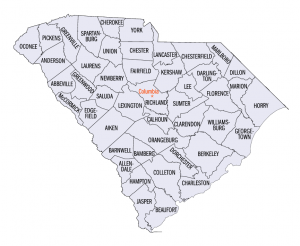INSIDE ISSUE 18.26 | JUNE 28, 2019
NEWS: Response to opioid crisis has only just begun, state officials say
BRIEFS: Lawmakers override McMaster vetoes, low ranking for kids, more
COMMENTARY, Brack: America has got to stop wearing blinders
SPOTLIGHT: The Felkel Group
FEEDBACK: Paper trails on voting keep people honest
MYSTERY PHOTO: Grand house
S.C. ENCYCLOPEDIA: Carolina Day recalls Battle of Sullivan’s Island
BIG STORY: Response to opioid crisis has only just begun, state officials say

By Lindsay Street, Statehouse correspondent | A Trump administration official praised South Carolina this week for its continued response to the opioid crisis.
“I was impressed with what’s going on with South Carolina,” said Vanila Mathur Singh, chief medical officer of the U.S. Department of Health and Human Services. Singh made the remark Tuesday during a S.C. House Opioid Abuse Prevention Study Committee meeting.

But people are still dying by the hundreds in South Carolina, according to the state. During that same meeting, S.C. Department of Alcohol and Drug Abuse Services head Sara Goldsby said that while the state has made strides in its response, work remains.
“We have been addressing it very well, but the reality is we are in a drug crisis, we are in an addiction crisis, and we can’t lose sight of our emerging threats,” she said.
And while there have been nearly 20 new opioid-related laws since 2017, lawmakers are eyeing more action in 2020.
The current crisis
In 2017, South Carolina had 748 opioid-related overdose deaths.
“We expect those numbers will continue to climb and not yet levelling off or going down,” Goldsby said. “Those are more than numbers; those are people who we care about.”
But there may be good news on the horizon, in contrast to Goldsby’s forecast. Preliminary national numbers from 2018 appear to show overdose deaths are declining nationwide for the first time since the 1990s.
About 20 states, including South Carolina, could see a decrease in overdose deaths. According to the early data from the Centers for Disease Control, South Carolina is expected to see a 5.2 percent decline in overdose deaths from 2017 to 2018.

“We know we’ve got a crisis. Despite what the numbers say, it’s still something affecting too many people,” S.C. Rep. Marvin Pendarvis, D-Charleston, said. Pendarvis serves on the House Opioid Abuse Prevention Study Committee.
Goldsby did not respond to multiple requests seeking comment. During her Tuesday presentation, she noted several encouraging signs in the state:
- So far in 2019, 12,000 pounds of prescription drugs have been dropped off with law enforcement as part of take-back programs;
- There have been 861 administrations of a drug that reverses the effects of drug overdose with more than 40 community distributors;
- Those in medication-assisted treatment have increased to 3,428 this year, up from 2,221 in 2018; and,
- There are more than 300,000 known South Carolinians in recovery.
Legislators at work
According to Goldsby’s Tuesday presentation, a 2017 law that requires practitioners to check a database before prescribing an opioid is working. In her presentation, she reported that prior to the bill being passed there were a half million queries into the database. This past May, there were 2.6 million for that month alone.
In 2018, legislators passed even more, including:
- A law requiring informed consent prior to prescribing opioid medication to minors (H. 3819);
- An act requiring prescriptions for controlled substances to be written on tamper-resistant prescription pads (H. 3826);
- A law making technical adjustments and revisions related to the scheduling of controlled substances (H. 4487);
- Authorization for DHEC’s Bureau of Drug Control to provide data in the prescription monitoring program to county coroners and medical examiners (H. 4488); and,
- A law establishing the definition of a “community distributor” as any public or private organization that provides services and assistance in relation to substance use disorder (H. 4600).
This past year, legislators passed two measures related to the opioid crisis:
- A law requiring health care facilities to submit certain information to the Department of Health and Environmental Control (DHEC) for inclusion in the Prescription Monitoring Program when a person is administered an opioid antidote (H. 3728); and,
- A law requiring veterinarians to complete continuing education on controlled substance prescriptions and monitoring (H. 3732).
The chair of the House committee who has spearheaded most of the legislation, S.C. Rep. Russell Fry, R-Horry, did not respond to multiple attempts for comment for this story.
Litigation in the works
One step in the opioid crisis has been litigation as public entities seek to cover costs of addiction.
Forty-five states, including South Carolina, and many counties and municipalities around the nation are suing pharmaceutical companies. There are more than 1,000 lawsuits pending, according to Regina LaBelle, director of Addiction & Public Policy Initiative at Georgetown University.
“There really is a groundswell of all these cases,” she told Statehouse Report. “States and localities are really overwhelmed with the amount of money they’ve had to payout in face of the mounting overdose deaths in their local communities.”
The S.C. Attorney General’s Office filed a lawsuit in 2017 against Purdue Pharma, an opioid drug maker. The lawsuit alleges the company created a public nuisance for unjust enrichment. The trial is expected for the latter half of 2020, according to the office.
 At least 42 of the state’s 46 counties have also filed two separate lawsuits, also against Purdue. A state-level lawsuit has consolidated the complaints from 38 counties, and a federal lawsuit, based in Ohio, includes municipalities and counties from around the country.
At least 42 of the state’s 46 counties have also filed two separate lawsuits, also against Purdue. A state-level lawsuit has consolidated the complaints from 38 counties, and a federal lawsuit, based in Ohio, includes municipalities and counties from around the country.
The counties in the federal suit are Newberry, Berkeley, Richland and Georgetown.
Purdue Pharma has denied any wrongdoing, according to multiple media reports.
The only counties that are not signed on to either the state-level or federal-level lawsuits are: Charleston, Chester, Marlboro and Darlington, according to a statewide search of cases that have been filed.
“We continue to weigh our options,” Charleston County public information officer Shawn Smetana said via text message.
But, LaBelle said, litigation is a limited response.
“That’s closing the door after the horse has left the barn in some ways,” she said. “This is one piece. There’s validity to bringing these cases but … we shouldn’t kid ourselves into thinking this is going to solve all our problems.”
What’s needed in 2020
One item awaiting senators in 2020 will be a House opioid-related bill that would make it a trafficking offense for a person to be in possession of four grams or more of the powerful and deadly opioid fentanyl. Just 2 milligrams of fentanyl can kill the average person. The bill is currently in the Senate Judiciary Committee.
Pendarvis said the House Opioid Abuse Prevention Study Committee, which has brought many of the opioid bills forward including the fentanyl trafficking bill, is working on two fronts.
“One is ensuring we get the drugs off the streets and, two, we get the proper treatment for the people going through this,” he said, adding that the committee is working on comprehensive legislation.
- The third annual S.C. Governor’s Opioid Summit is slated for Sept. 5-6 in Columbia. Learn more here.
Goldsby said her agency is working toward making recovery housing more available and offering grants for recovery organizations. She also said county-level strategies for medication-assisted treatment will be developed over the next year.
LaBelle, the national expert in state opioid policy, cited several states making strides: Rhode Island has implemented medication-assisted treatments at its correctional facilities; New Hampshire has created a recovery workforce program that destigmatizes addiction and helps with employment; and Kentucky has ramped up syringe exchanges and expanded access to medication-assisted treatment.
- Have a comment? Send to: feedback@statehousereport.com
NEWS BRIEFS
Lawmakers override McMaster vetoes, low ranking for kids, more
By Lindsay Street, Statehouse correspondent | State legislators gathered this week for a special session to override 25 of Gov. Henry McMaster’s 28 budget vetoes.

The number of budget vetoes was scant in comparison to previous years — accounting for less than half a percent of state spending.
Notable overrides included state money for outside expertise on elections in Richland County (estimated at about $50,000), and $2.7 million in state money to sink the Cold War-era submarine the U.S.S. Clamagore to create an offshore fishing reef.
The three sustained vetoes were:
- A proviso requiring the S.C. Department of Education to continue to operate a bus shop in Lee County;
- A proviso dealing with a decade-old sewer line project; and,
- A proviso allowing the Fort Mill School District to use impact fee funds to pay down debt, a move outside their original impact fee agreement.
Lawmakers also overrode McMaster’s veto of H. 3601, which allows conditional discharge for first-time offenders charged with public disorderly conduct. The General Assembly is not expected to reconvene again until January 2020.
S.C. continues to rank low for kids
The Annie E. Casey Foundation’s annual Kids Count report has ranked South Carolina 39th for conditions for children — a drop in rankings from 38th the year before. But all economic well-being indicators and all family and community factors have improved for the state:
- There are fewer children in poverty (245,000 children, representing 23 percent of children, down from 26 percent). There also are fewer parents lacking secure employment, fewer children living in high cost burden housing, and fewer teens not in school or not employed; and,
- Among the most improved factors is the teen birth rate per 1,000 births; that rate fell to 22 teen births per 1,000 births, down from 43 teen births per 1,000 in the previous year.
The state fared worse on other indicators:
- More eighth-grade students are not proficient in math — 74 percent, up from 70 percent; and,
- Moreg children ages 3 and 4 are not in school — 53 percent, up from 50 percent; and,
- There were also more child and teen deaths. The rate was 33 per 100,000, up from 32 per 100,000 the previous year.
- Read the full state profile here.
In other recent news:
![]() Higher gas tax takes effect July 1. The state tax on fuel will increase from 20 cents per gallon of gasoline to 22 cents per gallon on July 1. This is the third year of raises, which will continue until 2022.
Higher gas tax takes effect July 1. The state tax on fuel will increase from 20 cents per gallon of gasoline to 22 cents per gallon on July 1. This is the third year of raises, which will continue until 2022.
Senators to meet on education reform. A subcommittee of the Senate Education Committee will meet on the comprehensive education reform package 10 a.m. July 8 in room 105 of the Gressette building. Read the agenda here.
Economist says economic future uncertain. Clemson economist Bruce Yandle released a report this week that says the United States’ economic future faces uncertainty from federal policy battles over trade, deficits, immigration and foreign affairs. All of that creates an unknown future despite the nation’s low unemployment rate, rising wages and GDP growth, he said. Read the report here.
Lawmakers push for Santee Cooper to pay $15M. S.C. Sen. Hugh Leatherman, R-Florence, said in a letter to Santee Cooper’s leadership that the state-owned utility could be asked to foot a large part of the costs for at least two outside firms evaluating privatization and management of the utility. Read more.
‘Tax the Rich’ event in Columbia June 29. Tax March will hold a press conference 10:30 a.m. June 29 at the Statehouse in Columbia as part of the “Tax The Rich National Bus Tour,” calling for the repeal of the GOP tax reform. Learn more.
Looking ahead
Click below for other items coming up in the Statehouse:
Find any bill
- House bills
- Senate bills
- Have a comment? Send to: feedback@statehousereport.com
BRACK: America’s got to stop wearing blinders

By Andy Brack, editor and publisher | There’s a reason that a horse wears blinders: So it won’t get spooked by something weird that’s outside of its vision tunnel.
 All across our country, too many people are wearing blinders on an array of issues that is unraveling the fabric of the American way of life. We are ignoring big problems, hoping they’ll just go away. But they get worse and worse.
All across our country, too many people are wearing blinders on an array of issues that is unraveling the fabric of the American way of life. We are ignoring big problems, hoping they’ll just go away. But they get worse and worse.
Instead of proactively confronting issues from race and gun violence to immigration reform and the decay of our democracy, we keep drinking from the font of ignorance.
Where is the American spirit found in the lean and hungry Greatest Generation that won World War II and capitalized on innovation to thrust our country to become the world’s superpower? On a couch? Glued to a smartphone screen?
It’s far past time to stop wallowing in a tribalized, uncivil America and really pull together. Regardless of whether you’re conservative, independent or liberal, our way of life is at stake.
Just over 25 years ago, Time magazine art critic Robert Hughes wrote an incisive book that talked about America as a “collective work of the imagination whose making never ends” until it frays when mutual respect and the sense that we’re all in this together erodes.
In Culture of Complaint, Hughes observed, “The politics of ideology has for the last twenty years weakened and in some areas broken the traditional American genius for consensus, for getting along by making up practical compromises to meet real social needs.”
Hugues described the dangers of tribalism and intolerance: “In society as in farming, monoculture works poorly. It exhausts the soil. The social richness of America, so striking to the foreigner, comes from the diversity of its tribes. It’s capacity for cohesion, for some spirit of common agreement on what is to be done, comes from the willingness of those tribes not to elevate their cultural differences into impassable barriers and ramparts.”
 Yet in the last 25 years, Americans have retreated into algorithmic smartphones and idiot boxes that spew what they want to hear. Look around and see how the culture of complaint described by Hughes has morphed into a culture of ignorance in which major problems are ignored as people live inside personal bubbles of intellectual comfort. The corrosion is not hard to find:
Yet in the last 25 years, Americans have retreated into algorithmic smartphones and idiot boxes that spew what they want to hear. Look around and see how the culture of complaint described by Hughes has morphed into a culture of ignorance in which major problems are ignored as people live inside personal bubbles of intellectual comfort. The corrosion is not hard to find:
Immigration. The picture of a drowned father and his child in the Rio Grande River propelled the country’s leaders into a new round of finger-pointing. America is a country built by immigrants. We should be welcoming people fleeing oppression, not erecting barriers that lead to deaths and incarceration of children. We’re better than what’s now happening.
Climate change. You can’t “believe” or “not believe” in science because it uncovers facts and observations about what’s happening so we can engage in devising solutions. The globe is warming. Climate change is causing a crisis now, not in the distant future. Ignoring the consequences found by science puts everyone in peril.
Democratic institutions. Why aren’t more Americans mad that Russia meddled in the 2016 elections? Simply put, an enemy interfered with our democratic process and we mostly sit on our hands waiting for it to happen again. And what of President Trump, who may have obstructed justice 11 times as outlined in The Mueller Report? He makes light of Russia’s role in a fresh comment to his buddy, Russian President Vladimir Putin. People should be mad, not cozy.
Race. More than 150 years after a war that split America, the country still hasn’t grappled with race in our culture and daily lives. We’ve got to get beyond skin color and remember that everyone in America bleeds red, not white, brown, black or tan.
Gun violence. Too many people continue to be killed because of the proliferation of guns in America. We’ve become inured to mass shootings, a sad commentary on the state of the country. Instead of continuing to dither, people need to demand action. If lazy politicians don’t answer, vote them out.
Americans aren’t listening to each other. If we want to thwart the continued fraying of America and subdue the ignorance that’s corroding our institutions, we’ve got to unclog our ears and work collaboratively in good faith to attack the rot.
- Andy Brack’s new book, “We Can Do Better, South Carolina,” is now available in paperback via Amazon.
- Have a comment? Send to: feedback@statehousereport.com.
SPOTLIGHT: The Felkel Group
 The public spiritedness of our underwriters allows us to bring Statehouse Report to you at no cost. This week in the underwriter spotlight is The Felkel Group, a battle-tested public affairs and business development firm that assists corporations, associations and not-for-profits that are serious about their long-term success. The Felkel Group solves problems, crafts and delivers messages, helps organizations to manage crisis, and uses a wealth and breadth of valuable relationships to help to seal deals.
The public spiritedness of our underwriters allows us to bring Statehouse Report to you at no cost. This week in the underwriter spotlight is The Felkel Group, a battle-tested public affairs and business development firm that assists corporations, associations and not-for-profits that are serious about their long-term success. The Felkel Group solves problems, crafts and delivers messages, helps organizations to manage crisis, and uses a wealth and breadth of valuable relationships to help to seal deals.
The Felkel Group is also home to an outstanding advocacy tool called The Rap Index, a powerful intelligence tool that employs sophisticated computer modeling and profiling techniques to help organizations find their most effective advocates. To learn more about The Felkel Group and its Rap Index, go to: http://www.felkelgroup.com.
FEEDBACK
Paper trails on voting keep people honest
![]() To the editor:
To the editor:
North Carolina has used the paper ballot being scanned since the Bush-Gore election. The issues in Florida displayed ways ballots could be manipulated.
South Carolina deserves to have a paper trail. Paper trails keep people honest.
— Delia Frederick, Aiken, S.C.
Send us your thoughts … or rants
We love hearing from our readers and encourage you to share your opinions. But you’ve got to provide us with contact information so we can verify your letters. Letters to the editor are published weekly. We reserve the right to edit for length and clarity. Comments are limited to 250 words or less. Please include your name and contact information.
- Send your letters or comments to: feedback@statehousereport.com
Grand house

Wow, is this ever a grand house! But where is it? Bonus: Tell us what it is. Send your guess about the location of this photo to feedback@statehousereport.com. And don’t forget to include your name and the town in which you live.
Our previous Mystery Photo
 Our June 21 mystery, “Reaching out?” was a photo sent in by reader Vally Sharpe of Asheville, N.C. Several readers knew the picture to be of a moving piece of art at the National Memorial for Peace and Justice in Montgomery, Ala.
Our June 21 mystery, “Reaching out?” was a photo sent in by reader Vally Sharpe of Asheville, N.C. Several readers knew the picture to be of a moving piece of art at the National Memorial for Peace and Justice in Montgomery, Ala.
Congratulations to: Charlie Davis of Aiken; Greg Leventis of Oakland, Calif.; Vance Stine of Clover; George Graf of Palmyra, Va.; Freida McDuffie of Charleston; Bill Segars of Hartsville; Jay Altman of Columbia; Dale Rhodes of Richmond, Va.; Herman Blake and Frank Bouknight, both of Summerville; and Robert Saul of Greenville;
Graf shared that the monument is called “Raise Up” and is by artist Hank Willis Thomas.
“According to hmdb.org, this bronze sculpture is based on a historical photograph from apartheid South Africa, and depicts a row of male heads turned against the wall, arms raised in the air. The art historian and critic Kerr Houston explained the source: ‘In Raise Up, Thomas gives us the heads and arms of ten of the thirteen black miners pictured by Ernest Cole as they undergo a humiliating medical examination, in the nude.’ The shooting of Michael Brown in Ferguson, Missouri, which spawned the protest phrase ‘Hands up, don’t shoot,’ took place two months later. After that, this piece took on an unanticipated meaning.”
- Send us a mystery: If you have a photo that you believe will stump readers, send it along (but make sure to tell us what it is because it may stump us too!) Send to: feedback@statehousereport.com and mark it as a photo submission. Thanks.
S.C. ENCYCLOPEDIA
HISTORY: Carolina Day recalls the Battle of Sullivan’s Island

EDITOR’S NOTE: Today (June 28) is the 243rd anniversary of the Battle of Sullivan’s Island.
S.C. Encyclopedia | The Battle of Sullivan’s Island was the first major patriot victory in the Revolutionary War. In February 1776, after British plans to capture Charleston were revealed, South Carolina patriots began construction of a fort on Sullivan’s Island close to the main shipping channel at the mouth of Charleston harbor. Colonel William Moultrie was given command of the island’s forces and ordered to supervise the fort’s construction.
The unnamed fort was to be a square with five-hundred-foot-long walls and a bastion at each corner. It was built of thousands of palmetto trees cut to make two parallel log walls sixteen feet apart and more than ten feet high. The space between the walls was filled with sand. By late June only the two walls and bastions facing the channel were complete; thirty-one cannons were in place, and fewer than four hundred soldiers garrisoned the incomplete fort. At the other end of Sullivan’s Island, three hundred soldiers were positioned at Breach Inlet to block the British from crossing from Long Island (Isle of Palms) and attacking the fort from the rear.
A British fleet, which arrived on June 1, included nine men-of-war mounting almost three hundred cannons. On June 8 a British surrender demand was rejected, and the next day British infantrymen landed on Long Island. On June 28 the British ships advanced to attack the Sullivan’s Island fort. By 11:30 a.m. six warships were in position and opened fire. The fort’s guns soon responded. Not long after the bombardment began, three more British warships attempted to move into position between Sullivan’s Island and the mainland, fire into the fort’s unprotected rear, and block patriot troops from reinforcing the fort. But the movement failed when all three ran aground on the sandbanks in the harbor’s mouth. Two later freed themselves, while the third remained hard aground.
The bombardment continued into the evening, but the fort withstood the pounding from the British heavy guns. Its palmetto-log and sand walls absorbed the solid shot and shells, resulting in little structural damage. At the same time, patriot rounds tore into the wooden warships. During the afternoon when the British on Long Island attempted to cross Breach Inlet, patriots on Sullivan’s Island were able to turn them back.
At 9:00 p.m. the British ceased their attack and pulled out of the fort’s range. Several warships had been damaged, and more than two hundred sailors were casualties. Inside the fort fewer than forty patriots had suffered the same fate. The next day the British set the grounded ship on fire, which exploded when the flames reached the powder magazine. The British soon withdrew, leaving Charleston free from attack until 1780.
Shortly after the battle, the fort was named Fort Moultrie in honor of its commander. Fort Moultrie is administered as part of Fort Sumter National Monument, a unit of the National Park Service.
Today, South Carolinians remember the Battle of Sullivan’s Island as “Carolina Day” every June 28.
- Eight things to know about Carolina Day, by Jeff Quinton
— Excerpted from an entry by Richard W. Hatcher III. his entry may not have been updated since 2006. To read more about this or 2,000 other entries about South Carolina, check out The South Carolina Encyclopedia, published in 2006 by USC Press. (Information used by permission.)
Available in paperbrack, err, paperback
 Now you can get a copy of editor and publisher Andy Brack’s We Can Do Better, South Carolina! ($14.99) as a paperback.
Now you can get a copy of editor and publisher Andy Brack’s We Can Do Better, South Carolina! ($14.99) as a paperback.
The book of essays offers incisive commentaries by editor and publisher Andy Brack on the American South, the common good and interesting South Carolina leaders, such as former U.S. Sen. Fritz Hollings, civil rights advocate Septima Clark, former S.C. Gov. David Beasley and more. There also are discussions on civil rights struggles with which the Palmetto State continues to grapple. as well as commentaries on politics, governments, the hangovers of South Carolina’s past and her future opportunities.
We Can Do Better, South Carolina! is also available exclusively as a Kindle book for $7.99. Click here to purchase a Kindle copy.
- If you have a comment or questions about the book, please let us know at: feedback@statehousereport.com.
ABOUT STATEHOUSE REPORT
Statehouse Report, founded in 2001 as a weekly legislative forecast that informs readers about what is going to happen in South Carolina politics and policy, is provided to you at no charge every Friday.
Meet our team
- Editor and publisher: Andy Brack, 843.670.3996
- Statehouse correspondent: Lindsay Street
More
- Mailing address: Send inquiries by mail to: P.O. Box 22261, Charleston, SC 29407
- Subscriptions are free: Click to subscribe.
- We hope you’ll keep receiving the great news and information from Statehouse Report, but if you need to unsubscribe, go to the bottom of the weekly email issue and follow the instructions.
- © 2019, Statehouse Report. All rights reserved.
















